
Welcome to the course my name is Alex Genadinik and I’ll be your instructor.
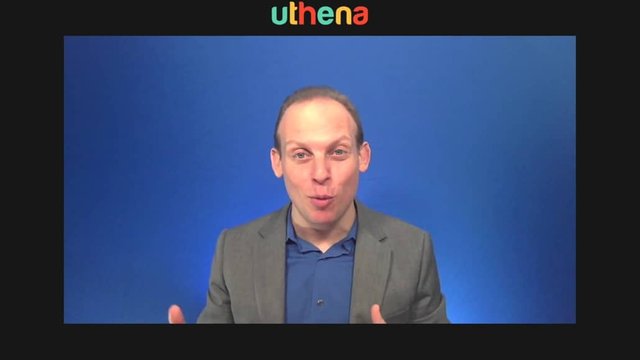
I sincerely appreciate the time and trust that you’re putting in to me in this course. I put a lot of time into this course. How about five years? That’s how long I’ve been in the e-learning industry and only now after all the trials and errors, and all the bloopers, and all the mistakes I’ve made, and all the things that I went through to perfect it, I’ve put together a course on how to create the best in niche, the best in category course.
Because that’s really the way to win on a site like Udemy or to do right by your students, is you’ve got to aim to make the best course for them, so that they get a lot out of it, so that one day you can sit there and say, "Hey, you put a lot of time and trust into me, I honestly have really gone out of my way." Did all the work to make the best course.
That’s what I did for you here and the aim of this course is so that you can one day say that to your students. In this course, I’ll go over exactly how to make an ideal course, how to pack it with exactly the right content, what kind of course to make so that you can display your best expertise. How to film, how to do the audio, how to do the lighting, the background, different filming formats, how to make it in terms of instructional design, so that it teaches, and so much more that goes on into a course.
I’ve actually put together a 40-point course quality checklist that’s also going to be a part of this course, and every item in that 40-item checklist is addressed in this course. I'll teach you how to get that part right so by the end of this course, you’ll be able to create a fantastic course of your own to sell on your site, to sell on Udemy, wherever you want and that’s exciting. I hope you’re excited to get started. I’m excited. Let’s get going with the course.
If you will enjoy reading and contributing to the discussion for this post, will you please join us on the YouTube video above and leave a comment there because I read and respond to most comments on YouTube?
If you find anything helpful in this video or funny, will you please leave a like because you will feel great helping other people find it?
Lesson One: Where to Sell and How Much You Can Earn.
In this video which is really fun because it’s going to talk about where you can sell your courses and how much you can make.
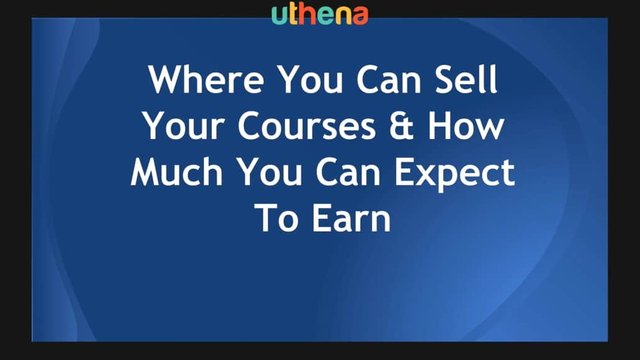
I’m going to give you three distinct strategies for selling your courses. A lot of sites and resources for where you can tell your courses and how much you can expect to earn. I know that’s the question a lot of new course instructors have; how much can I expect to learn?
Let’s get right into it.
Three ways to profit. The first one is selling from sites like Udemy and Udemy itself, and like Udemy. We can categorize these kinds of sites as user-generated content websites. This is where you, the user, generates the content. It’s extremely competitive. These are also called platforms. There’s a lot of courses on almost any topic, let’s say cooking. Well, they’re probably 50 courses on cooking so you have to stand out, but there are many students. It’s competitive but the benefit is that these sites already have students who want to learn, who want to take courses, you don’t have to convince them as much. People there are only taking courses so it’s got a good audience for you.
In Udemy, for example, the average instructor revenue per course - and this is an average, very rough average - is around $3.50. I know you might see a lot of courses are priced at $10, $15 per sale but including all affiliate commissions and Udemy commissions and all these typical per sale averages $3.50 per sale, per course. Very low.
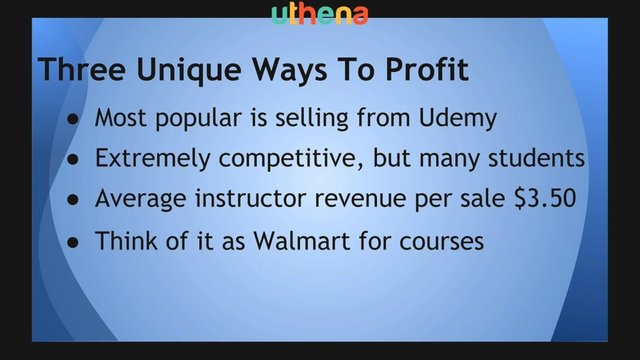
It’s almost like a Walmart model. A lot of sales are very cheap prices. If your course, for example, is in a niche where you don’t expect a lot of sales then this might not be the exact best model in your case. If you have a niche that has tremendous global demand - let’s say you’re teaching people a programming language, you’re teaching business or teaching marketing, or teaching design, or Photoshop, or how to freelance - something big and ubiquitous then this is perfect for you because you can get a lot of students. If you’re wondering how much money can I make? Well, there are I believe 12 instructors in Udemy who make over a million dollars a year, and there are many who make six figures a year.
Of course 90% of instructors on Udemy make maybe less than 500 a month but it depends on the amount of hard work you put in. Usually it does take new instructors on Udemy to ramp up. The first few months are usually very disappointing and if you stick with it then things typically grow and go well.
The other issue new instructors on Udemy encounter is not being able to get over the unreasonable proportion of value that they give to revenue that they earn.

You might be a 20-year experienced professional and here you are selling your expertise for $3.50 a pop. That is wildly unfair, I agree but that’s the Udemy world. If you can’t get over that, you don’t have to get over that, but if you can’t get over that it’ll be hard for you to really do well on Udemy because even at that revenue level, you still have to make amazing courses because it’s an it’s a competitive marketplace. You can’t just make little tiny courses because people just won’t like them because there are probably better courses available for exactly the same price but much better.
There are other options like other elearning sites. Udemy’s biggest competitor is a website called Skillshare.com whereas Udemy pays per enrollment Skillshare pays per minute watched, and typical instructor revenue, of course, individual case that isn’t very but typically instructors make about ten times less on Skillshare than on Udemy. You can always upload the same course to both sides. It takes almost no time to upload to the extra website so you can just get a little bit of extra income from Skillshare and don’t worry if you wonder can I really upload it? Is that legal? Is that allowed? Yes, that's allowed because under the licenses of these course websites like Udemy and Skillshare you own your content, so you can upload it anywhere you want.
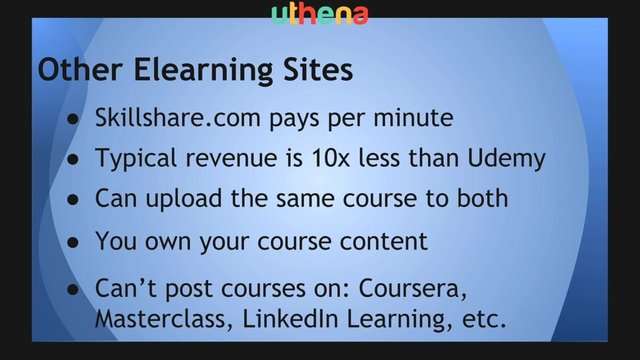
There are a few other websites that are very popular in the elearning space where you cannot post your content sites like Coursera, Masterclass, LinkedIn learning, that used to be Linda, and so on, and so on and so on. A lot of these either require professional college instructors or it’s invite-only, or something like that.
Udemy and Skillshare are generally the two places where as an expert and without having to be a professor, you can tell your courses.
Let’s talk about other ways to sell your course. There are smaller sites like Udemy and Skillshare so maybe like the third, fourth, fifth, and sixth sites like that typically, they make almost no money. Typically it’s a waste of time unless they specifically focus on your niche, but generally after Udemy, after Skillshare there is a tremendous drop in effectiveness on those sites, so I’d almost recommend not wasting your time on any of those.
The second option outside of the user-generated content platform is to sell from your own website. There’s some advantages to that, you can promote it in more ways. You can run more kinds of ads, you can charge higher prices for your courses, which a lot of instructors really appreciate, you can keep student emails. Whereas on Udemy and Skillshare they keep the student emails, you don’t have a student email, so the client is not really yours, and you generally have more control, but it’s harder to sell on your site. Because smaller sites have less trust.
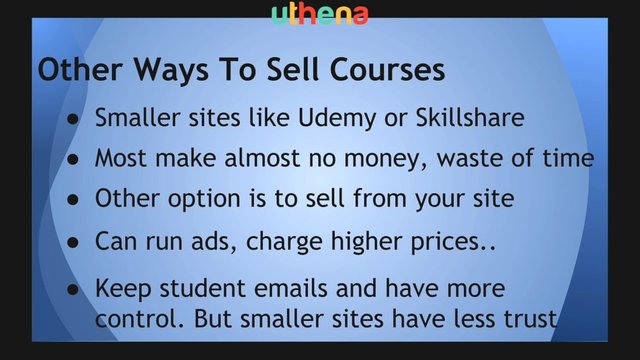
Udemy is a big, big brand. It’s known, it has more trust and so it’s easier for them to sell. It’s harder to sell on your site. If you want to sell through your site, the typical sales channels are running ads and SEO - which is search engine optimization - and promoting through your own following if you have an audience on social media or email. Of course, that and getting affiliates and influencers to promote your products.
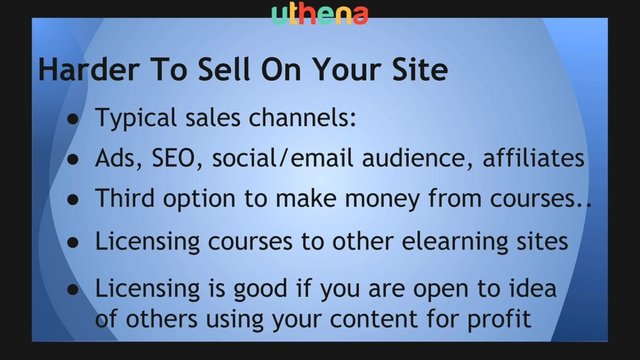
None of these are particularly easy to get right or to get profitable but these are the channels that you have available, and if you have your own audience, they’ll buy at a higher rate because they perceive you as an expert.
That was the second option. The first option just to recap was to sell on user-generated content sites. The second option was to sell on your own site.
The third option is you can license your courses to other elearning sites. This is only a good option if you’re open to the idea of other sites using and profiting, and maybe even editing your content. If you’re not open to that licensing is not a good option for you, but if you are open to that we’ll discuss that later in the course.
It is something most people don’t realize they can do. It’s quite profitable because you get a you get paid a big chunk of money up front for the license fee. Just to give you a sense that I have licensed my own courses for up to $5,000 per course. That’s on the very high end in my case.
Usually a license now is two, three, four or five hundred dollars per course. That’s a typical fee it’s one time upfront. If you have many courses you can license many courses and it’s a few thousand dollars for a number of courses if you can do that. It can be a good one-time chunk of revenue. It’s not often that you can license courses, but we’ll talk about that later in the course, and I’ll give you more insight about that.
For now, you understand exactly where to sell, how to sell, and what you can expect.
Lesson Two: Udemy Course Topic Research.
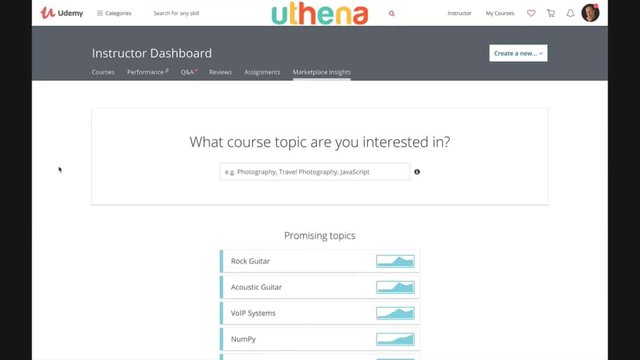
Udemy gives a tool for gauging which course topics are going to be good, which course topics are going to be lucrative, and which course topics are not. If you navigate to it on your instructor's dashboard, it’s this marketplace insights. If you don’t have this, that means you haven’t applied to be an instructor yet. What you want to do is immediately go and become a Udemy instructor.
I can’t show you how to do that because I’m already an instructor but it’s very easy. It’s in yours here. It’s like in this area.
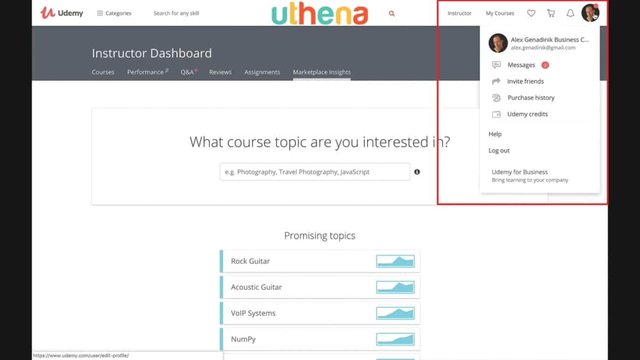
You just say there should be an option for you to become an instructor, teach on Udemy, and then they’ll approve you in like half a day or a day. Then you’ll be able to have access to this marketplace insight. When you’re on it here’s what we do.
Let’s say rock guitar. This is not something I chose. These are some topics that I just saw. I don’t even know what they are.
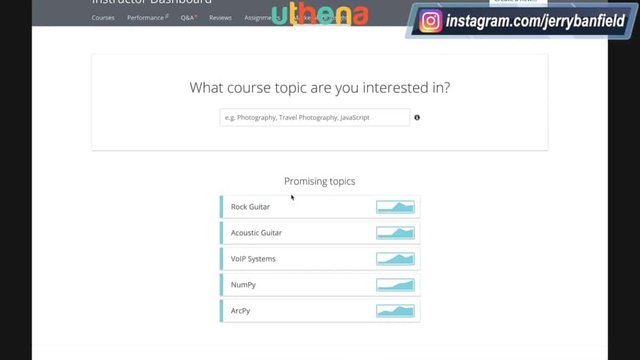
What’s Numpy, what’s Argpy? I have no idea so let’s say we look up rock guitar and Udemy says this topic is a great opportunity. The average course makes $42 a month. The top course on this makes $454 a month. There’s not a lot of courses so you’ll have a low amount of competition and you have high student demand.

It’s a great topic in terms of it’s not that competitive. This might not seem $450 like a life-changing amount especially that’s the best one. The average one is even worse, ten times worse, but the thing is that you remember you’re not going to make just one course over time you’re going to have a library of courses. If you have a hundred courses that make that much, wow, that’s amazing. It depends how many courses you’re planning and again, it’s largely passive and the courses are not entirely passive, but it’s largely passive, so at the same time as most people would say this is not life-changing money, most people will also say, "I’d still like to have it." We are in that situation.

You have a little bit more analytics on this. Let’s go through some more common topics. If I close this rock guitar and let’s say I say cooking. Udemy actually gives some categories that it has. We have Chinese cooking, Indian cooking, let’s say cooking for now.
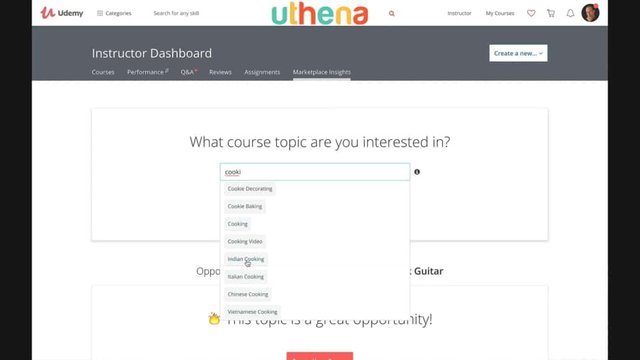
It's a very broad category. So one of the top courses in cooking makes $1,612. Not bad for a cooking class, right?
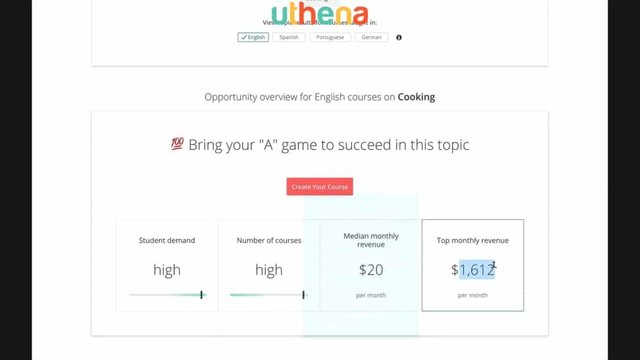
The average course doesn’t do so well and you see competition here is high. Let’s try another cooking class, maybe Italian cooking. Well, this was not as popular.
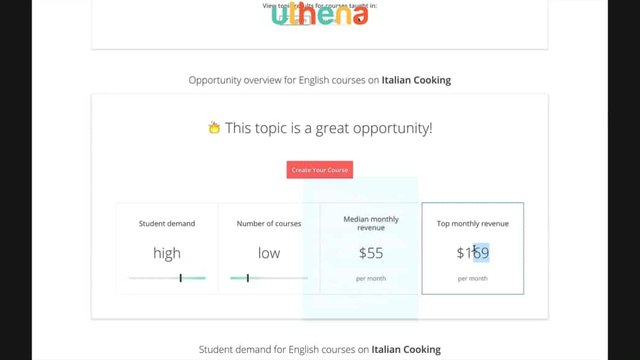
Let’s try to get away from cooking. Let’s go Java programming. You’re going to be like holding on to your pants. Java is a programming language if you’re not familiar. There’s going to be a big number here.
Yes, you see it correctly. The top Udemy course on Java programming makes $34,105, per month. That’s one course per month. The average course doesn’t make that much because the top few courses are very winning and most students don’t buy other courses, most students buy the winning instructors courses, but at the same time, there are some instructors who make tremendous amounts of money.
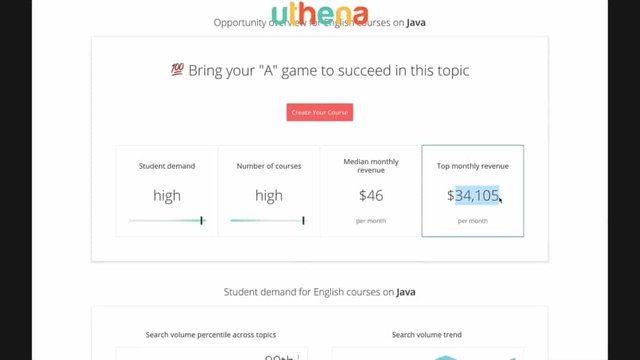
Let’s try another one like that just to get you excited. Let's talk about web development. $77,616. Incredible.
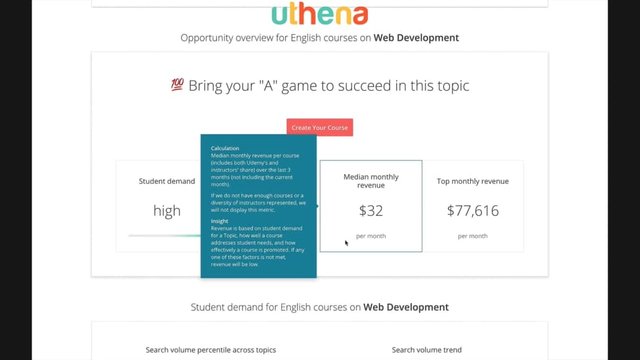
That’s perhaps the most popular Udemy course but let’s try Python. It’s another very popular topic. Programming is very, very popular in Udemy. Whoa. Incredible, right? I thought that the other course was the most money-making but this is just wild. So that’s how you research the courses.
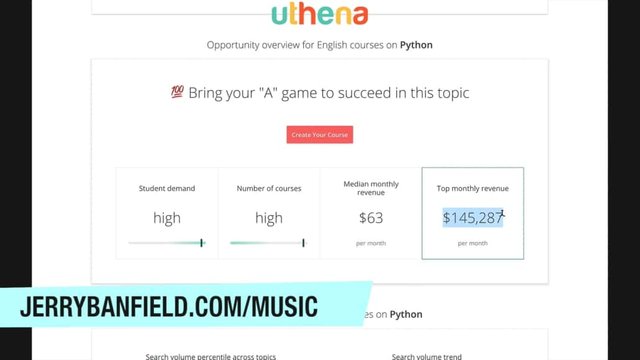
Keep in mind that the average Python course doesn’t do almost anything, so your course has to be some of the best. What you do next is you go and you search like Python right on Udemy, and you see well, who is this person? I have met this person who owns this course. He’s a nice guy.
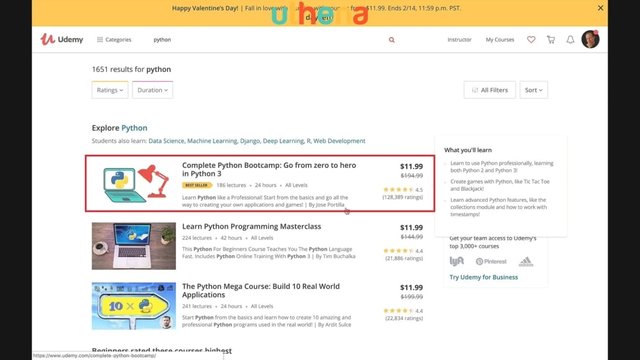
This is Jose Portilla and you have to go and look at this course and see, can you make a better course?
Even if you can make a marginally better course, it’s probably not going to help you because the truth is that it’s going to take a long time to catch that person. I mean he has such a head start so what you want to do is have something different.
You don’t want to compete head-on with a giant, especially not with your first course. You want to go for other niches or maybe what I would do if like let’s say you do want to compete with a giant which you want to do is go to that course, maybe even buy this course see what he does right, and things that he does right, you have to ask yourself honestly can I make a better course?
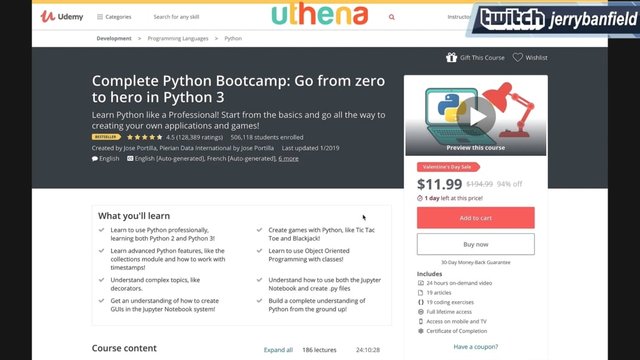
If yes, go for it. If you don't improve your skills and try, do your best to make a better course because you always want to ultimately end up with the best class in a category. Because quality usually wins and essentially this is how you use Udemy data to look for student demand, and to research whether a course has high competition, low competition, high demand, low demand, and how much money you can expect to make as well.
I’ve collected a number of topics that I have education in, relevant work experience, and my hobbies.
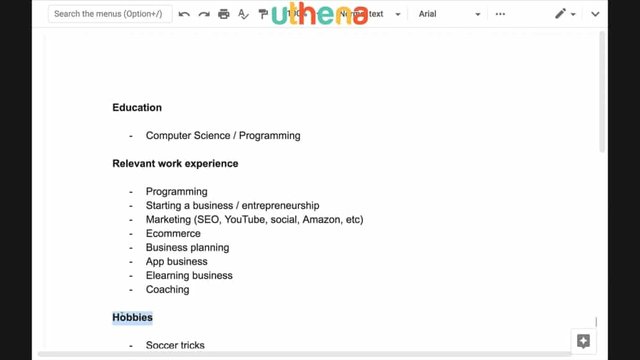
Let’s go through them and I’ll show you how I think about choosing different topics, and you can follow along, and then, I’ll show you what I’ve done with my courses, and the results from them.
My education was in Computer Science and I did work as a software engineer so I’ve got that here and here, but that was a while ago. I did program my mobile apps but that was also a while ago. I’ve kind of stepped out of programming and so my programming is a little outdated. I am by no means an expert and if I was to try to make a programming course now which I don’t probably that course would not be the best in its niche.
I do have one programming course and I’ll show you that course now, and I’ll show you how that came about. This is a programming course it’s Learn Android App Development & Promote Your App like a Pro. You see, I did it with a co-instructor.
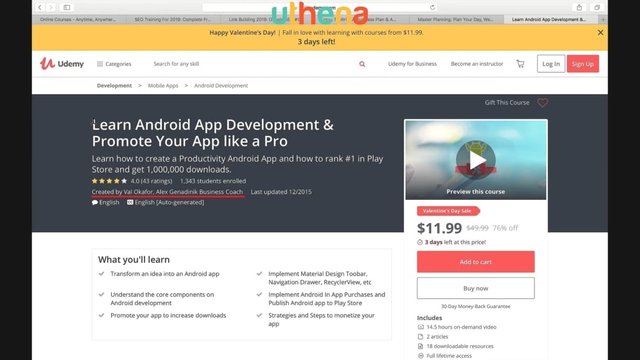
I did this course with Val Okafor and I’m a co-instructor here. He showed all the programming and I showed how to promote the app so that’s another thing you can do, but Val did that course once and then he really didn’t do many more courses. He didn’t update this course so this course got a little bit outdated as you can see last updated 2015.
This is wildly outdated by now. Having a co-instructor, you don’t know if the constructor will stay with the course. You’re dependent on them and this course is probably over the lifetime of this course made between $1,000-2,000 which is not bad but it’s certainly no dream.
The top Android course on Udemy has made millions of dollars in the same time span, so you see it’s wildly unperformed top potential. This was probably not the best thing to do. From the onset this was probably doomed to fail. Maybe it’s a little bit harsh to say, but it was doomed to certainly not reach the top, but if I had partnered with that top instructor on some kind of a niche topic that would have been fantastic.
So partnering with top instructors does work, but partnering with relatively new instructors has a far smaller chance of succeeding.
Let’s get back to looking at the course topics. Now you understand why I don’t make computer science and programming courses even though potentially programming and software engineering is the number one most lucrative niche in online courses. That’s the best place to be in but you certainly have to be a super expert otherwise, it’s just hard to compete as I’ve shown you.
I had to reach into what’s my relevant work experience in addition to that, and most current, and we’re I’m now an expert. It so happens that I have a personal brand, around business entrepreneurship, business planning, starting a business, and all of these other topics. Starting a business, entrepreneurship, marketing in very different ways, the e-commerce business that I do, business planning, app business that even though I’m not a top app programmer, certainly my own apps that I’ve built have had very good success and I teach the app business with success. I’ve done elearning for about five years and only five years in I’m making a course on how to get into elearning. First, I wait to become an expert then I think can I really make the best-in-class course or course that students will be really happy with? Then I make the course. I also have a lot of coaching clients.
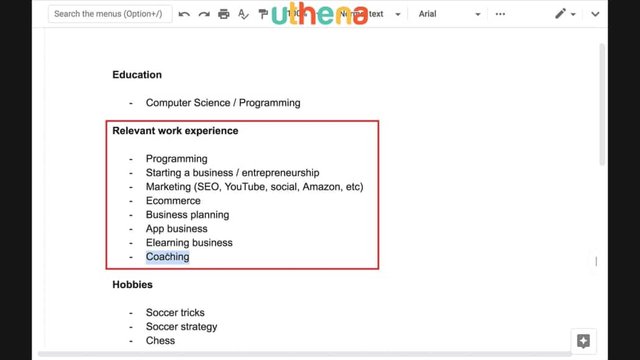
So in elearning I don’t just bring in my own experience. When I make a course I’ve coached maybe a hundred different course instructors at varying levels of their course creation career.
I’ve had those conversations. I see how insights help them. I see what insights they already feel like they know. Just because I see their faces I have conversations so I know what kind of things to share because that’s where I’ve gotten the aha, moments from actual live clients that I’ve coached. This is the bulk of my courses that I’ve been successful with around business, marketing, and niche business topics.
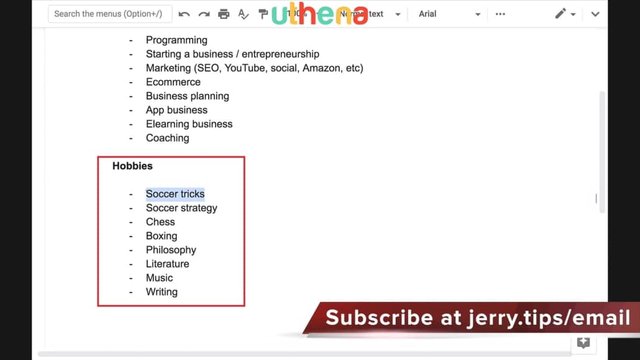
There’s some hobbies that I’ve done. I’m kind of good at soccer tricks. I can’t do all of them but I can do almost all of them. I’ve just played soccer for a long time.
There’s a course I can do on soccer tricks. It’s not helpful for anybody to make money or a career, but it’s kind of cool. I wouldn’t expect this to make a lot of money but it’s kind of a cool course for me to make. It would be really fun for me to make, and the soccer strategy which is game strategy which is different from just doing cool tricks. I’ve played chess. I have a national rating but it’s not a fantastic one.
Boxing, I’m a beginner so we’ll talk about that in a second. Philosophy, I’ve studied for a long time. I’ll show you the result in a second.
Literature I’ve studied for a long time but it’s such a wide topic I don’t know what to teach, but I do like writing, and I have written successfully. I happened to generate a significant income with my writing that I enjoy doing and it’s a hobby.
I do have courses on writing because I know how to write. I know how to make money from writing. I would say that I’m successful at it. This hobby I did make courses on and the music I am too much of a beginner, mostly a listener, mostly a dreamer of making my own at this point. I love this topic on its own. I didn’t make courses on this, and I didn’t make courses on chess, and I don’t have courses on soccer but I have courses on a few other hobbies.
Lesson Three: Reviewing My Course Creation Journey.
Let me show you my courses and how they came about and we’ll go through it and it will be clear what I tried, what worked, and how you can structure your own course path. This is my Udemy profile.
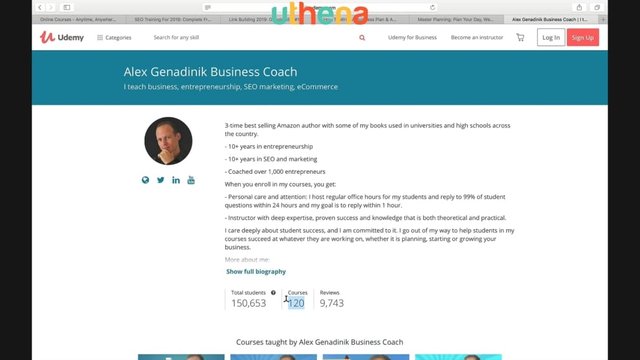
It says that I have 120 courses. I have many, many more. Many of them are private, many of them I have done for other instructors that I’m not visually seen on them, and many I have taken down because I didn’t think they were good or on brand.
I have 120 courses. Whenever you watch this it might be higher it might be lower, but it’s still somewhat significant of a number. Even if it’s over 100 it's still pretty good.
I’ll show you my courses from the beginning ones to the latest ones and I’m not promoting these courses. I’m just trying to explain to you my course journey, so you understand how to structure yours.
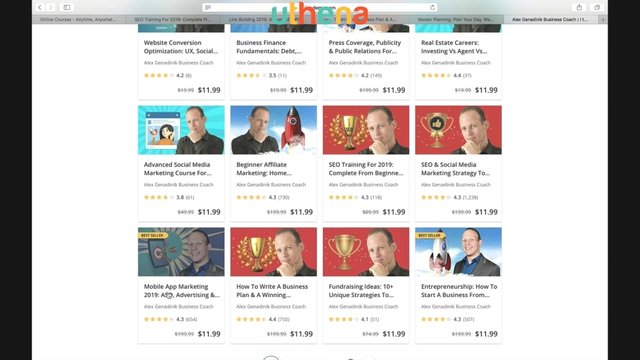
You see that my first courses were on entrepreneurship, mobile apps, fundraising - which is something that entrepreneurs ask about - business planning, SEO, and social media and things like that.
They are within my deep expertise and those have done really well. When I look at real estate careers, I don’t know anything about this.
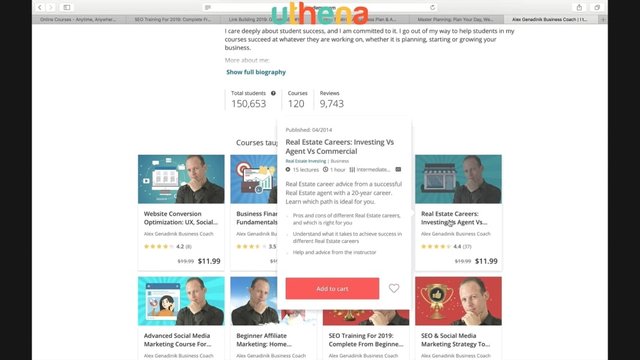
This is a course where I interviewed a real estate expert. I’ve not been able to refilm this course. This course miraculously has a relatively good rating for now but it is very old quality of video, and I’m surprised that it has stayed up in the ratings.
The website UX course is also one where I interviewed an expert, and the finance course is also one where I interviewed an expert. I had a phase of experimentation where I interviewed people. This course I also interviewed an expert and then it wasn’t doing well because it had bad quality and I had to entirely refilm it and now I’m the only instructor in it.
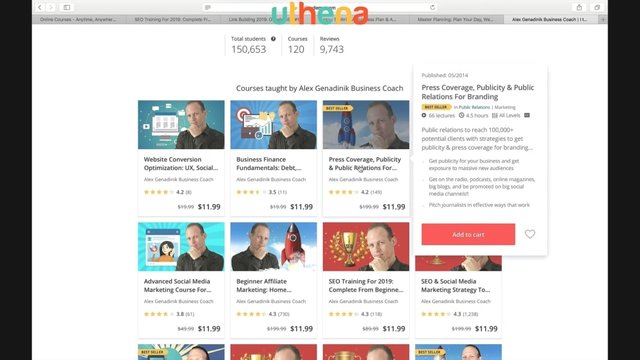
You see another course that I did with a co-instructor, it’s got really bad reviews, I’m considering taking it down.
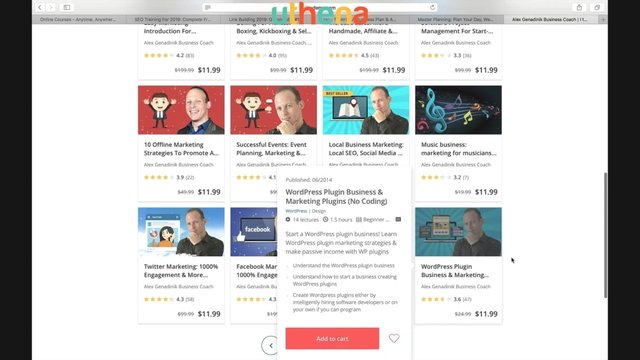
This is another course where I interviewed somebody. I don’t know much about the music business very much. I interviewed somebody who I thought was an expert and I’m thinking of taking this course down because it’s off-brand for me and it ruins my rating.
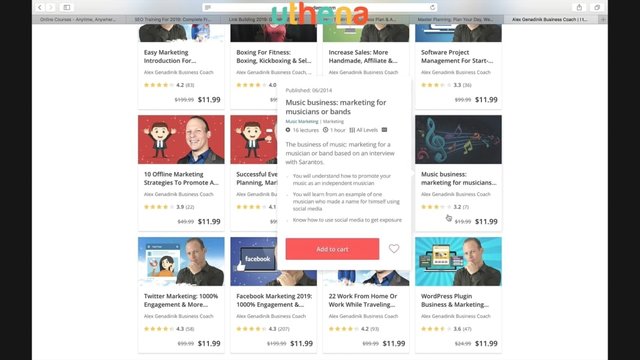
The topics I teach are Facebook, Twitter, offline marketing, and local marketing events. These are the things that I’ve done. Here’s something interesting. Boxing for fitness. Interesting. I’m not really an expert.
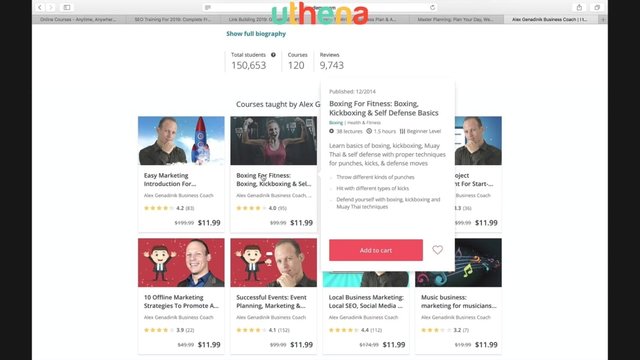
This course has done okay. It hasn’t been that bad it has a 4.0 rating now but typically it has a higher rating. It typically fluctuates but this is the low of its rating and I did this course with an instructor. I’m not the main teacher here, I invited an instructor. The problem with this course is that this was done a few years ago. I've not been able to refilm it and make it better. There are some audio and visual problems with this course.
The content is good but the quality of the course hasn’t been improved and so other courses have come along that are better. That’s another issue with co-instructors, it’s hard to get them to refilm. But this course is okay. It’s just one course. If a potential buyer is browsing my courses, they might be a little taken aback like why is this guy teaching boxing? It’s a little off-brand, it’s not that bad.
By the way, one thing that I thought early on, I remember doing some kind of a podcast interview and somebody was asking me-- this is like 2015 or something. The person asked me, “Alex, you have 15 courses that you’ve made. That’s so many.”
At that time I only had 15 and I thought, yeah, that’s really too much and I’m out of ideas for courses to be honest. I told that person during the interview yeah, I’m probably not going to make any more, and here I am I’ve got 120 and even though I’m filming this course I’ve got ideas for 10 more.
As you keep working, as you keep gaining expertise, as you keep talking to clients, you always get more ideas for niche courses, but you’ll notice that my course is within a certain niche; business, marketing, entrepreneurship, and subtopics inside marketing, and things like that.
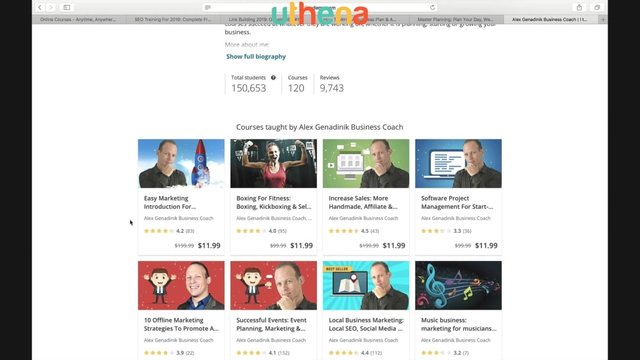
While I’ve gone a little bit outside of my deep expertise, those courses have been worse because I haven’t been able to deliver high, high insight.
Here’s another course that’s totally off-brand for me and this is still around 2015 maybe 2016. Philosophy of religion. Totally off-brand unusual but it just so happens that I’m a total philosophy geek and this course is not opinions by me. I collected philosophers from like the last 2,500 years and I gave a survey of what they all said about religion. I didn’t name any religion by name but I just gave general ideas about it.
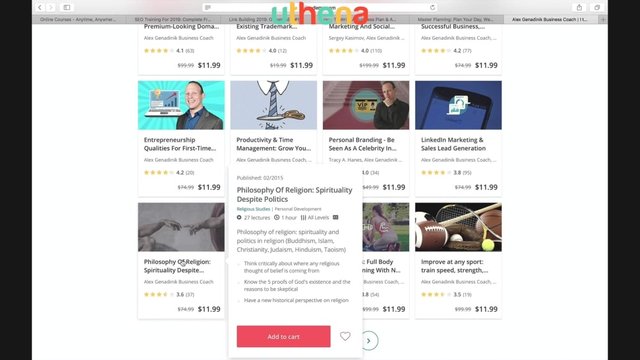
The problem with this course is that the video quality was really bad. This course never became too successful. It still makes a tiny bit of money passively. I haven’t updated it but generally people are taken aback by the video and audio quality. It truly is bad because it’s back in the day and I haven’t really refilmed it because it’s not on-brand for me.
My main focus is things that are on brand, winning in my brand because competing inside my niche business and marketing is extremely competitive, and all my efforts are going towards that.
Constructing or doing top courses that you’re not an expert in ends up mediocre, and also not improving and refilming old videos also ends up mediocre.
Because everybody else improves and if you don’t refilm, and improve your courses, they remain mediocre, never really sell a lot of money, just a tiny trickle which is not great.
I’ll show you something else, for example, courses that have done really well are these YouTube courses. It’s one of the top courses on Udemy. I keep improving it and I keep getting positive student feedback on it and it is one of the top Udemy courses about YouTube.
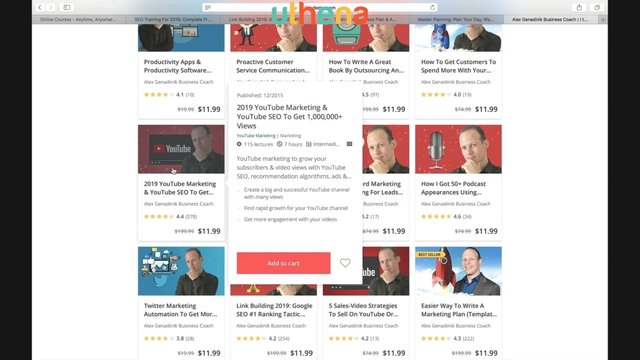
I have a channel on YouTube with a couple of million views. I’ve been on YouTube for a number of years. I know YouTube really well and I’ve been able to refilm it, improve it, and provide some of the best insights. That’s true for a lot of courses, for example, I have this course on Amazon.
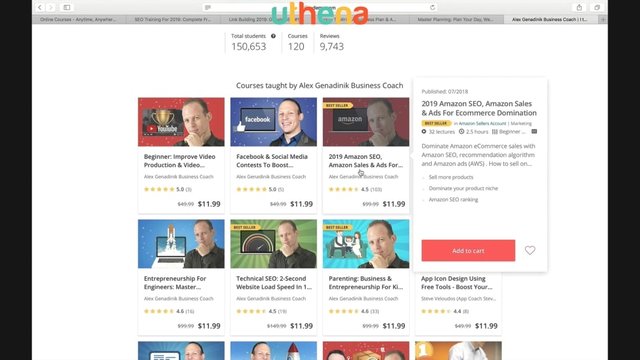
It’s a relatively new course but it’s got a good reviews and it’s a best-seller because in this course, I show some really cool stuff. For example, this course shows how I sell products on Amazon and how one of my clients, who is a million-dollar seller, sells on Amazon, so it’s got extremely successful case studies.
You see things where you can show true deep insight that’s really fantastic, that’s really what makes courses successful. Things where it’s middling level insider content and mediocre courses get mediocre results.
Now, you see how I have approached my hobbies, co-instructing, and the results that I’ve gotten. I will tell you that even though I have this big number of courses, my top 10 courses make about 80% of all my revenue. It’s not about this number, it’s about how many courses you have that are great. That’s the money-making question.
Lesson Four: Using Google Adwords To Find In-demand Course Topics.
In this video I’m going to show you how to research demand for a course using the Google Keyword tool, and here I am. It is on google.com/adwords.
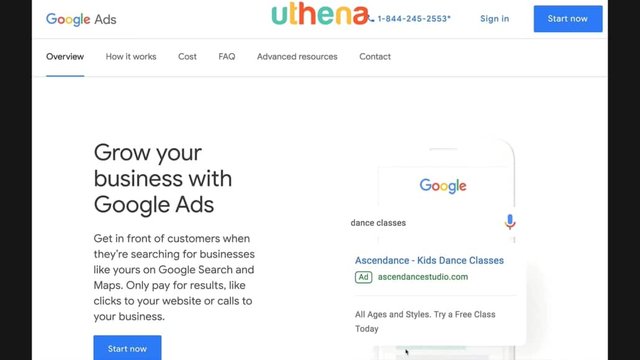
What we’re going to do is to sign in and if you have an account with Adwords or if you have an account with Google, you already have an account with this because Google accounts are all universal. I’m just going to log in here like me.
If you have a new account, they might ask you to start setting up your Google AdWords account and run your first ad. You can do that and run your first ad for like a penny just to get around that, but I’ve never seen that happen to me because I already have an old account. Once you’re logged in and once you get through all the setup steps, what you want to see is that they have this wrench tool, and under that they have PLANNING, and Keyword Planner that’s the interesting thing for us now.
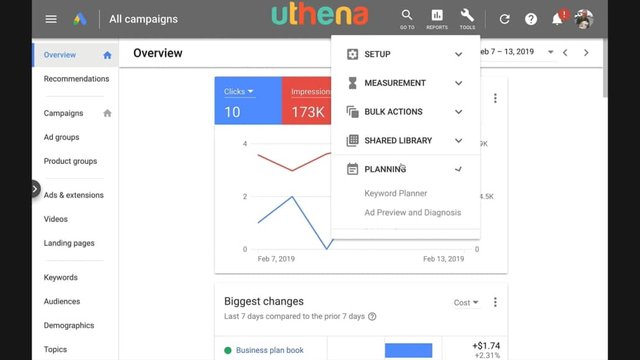
This is going to give us data on which keywords are in demand. So let’s say you’re planning a course on a cooking course. You put the keyword cooking course here and you say get started and what is going to show us is how many people are specifically looking to buy a course.
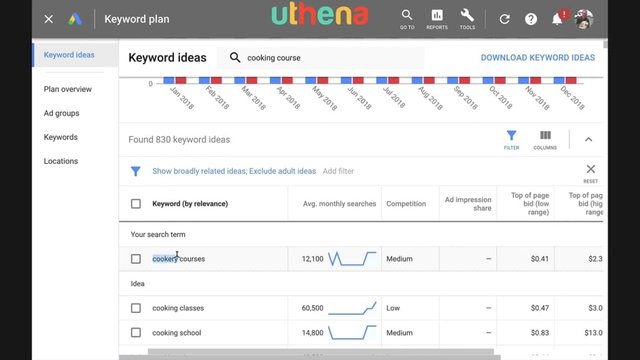
Well, I don’t know what cookery to be honest is but cooking classes are okay. There’s a lot of people searching for cooking classes more than I would think. It’s people searching for in-person cooking classes so it’s a different thing, so then you think oh, okay, so cooking course is a little hard to research. Maybe we can do an online course. Maybe people would phrase it like an online cooking course, but this is amazing. There's a pretty significant demand for online cooking courses - 1,600 people - and you know this brings in paying clients.
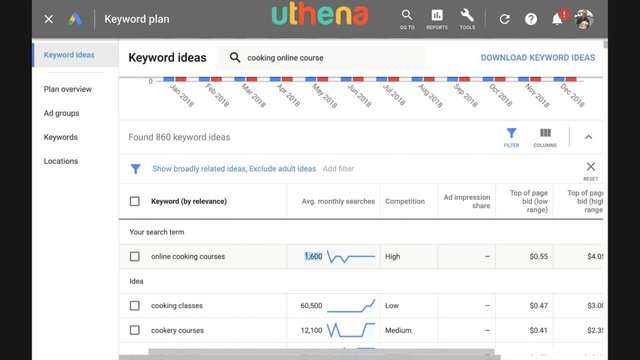
They’re not going to take free courses so this is pretty good. That’s a healthy number. Ask what’s a healthy number? Anything in the thousands is great because that’s a good number of potential clients and traffic for you to get. The main challenge is going to be to rank for that keyword because guess what? All the major elearning sites are going to be ranking for that so it’s not easy to rank for these keywords necessarily, but right now we’re not even researching that, we’re just researching demand.
Let’s say like we look at different keywords, for example, we have that cooking course, we’re going to try another type of course. I searched for this online yoga course and very nice, almost 2,000 people. This is great.
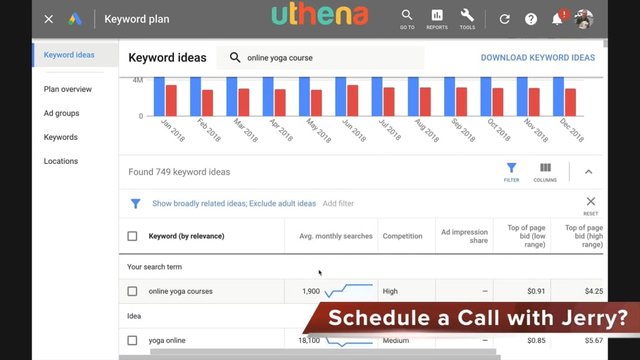
There is demand for these topics. If we do a Python course. Python is a programming language that’s popular and see almost 10,000 people are searching for it on Google, so there is good demand.
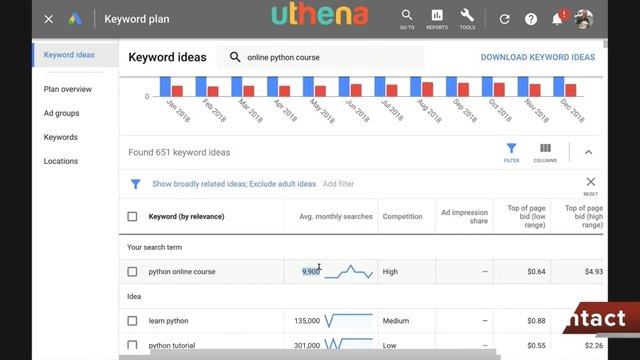
If you can get in front of these people it would be fantastic, so this makes me feel confident about the demand.
It’s not just these keywords right you can go programming course, class, so you can have a variety of keywords. There’s more demand than that and more different ways in people search. I'm just looking for the basics so obviously more people are searching for a course than a class, but looking at classes still gets almost 1,000 people.

You can also go down and see learn, like learning Python. When people search for something like learn or tutorial, they probably want free content and we don’t want free students.
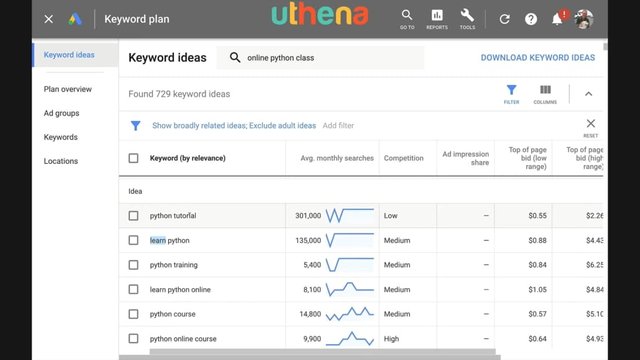
Training, now when people search for training, training implies that it’s a paid thing. Learning or tutorials implies that it’s a free thing. Learning Python online is likely they want something free. Python course is probably a paid thing. So courses, classes, trainings, they’re paid. Tutorials they’re free.
You can kind of take a look at all the terms. This gives you a variety of terms that people search for, and you can get a sense of what people want to pay for, and what they want to get for free. You don’t want to target the free search keywords but you definitely want the paid ones especially let’s say oh, can you turn your course into a book?

Well, a lot of people want a book, so that’s how you do the basic keyword research to tell demand for your course on Google search.
In another part of the course, I'll show you how to research demand inside Udemy but now you can complement that with this research of demand on Google search. You get a much more holistic view of the demand for your topic.
Lesson Five: Creating An Amazing Course Outline.
In this video, let’s go over how to create a great course outline that gets students from point A to point done, complete and they’re going to be able to accomplish something.
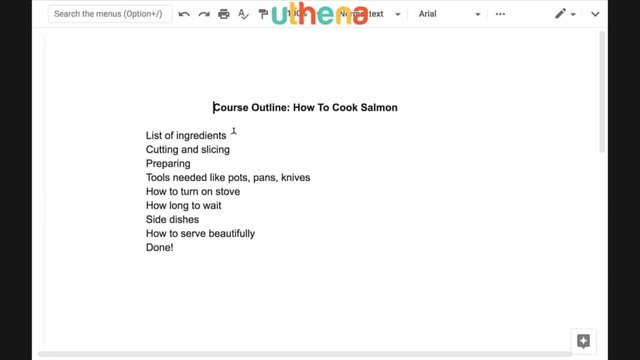
In this course the example I’ve created is something a little bit random different from my other examples just to give a little variation. How to cook salmon.
So what do we think is needed? First of all let’s say introduction is needed, who are you, then list of ingredients - what might go into it. When I go through these essentially this is the course, this is the course sections, which you should think of as chapters in your book. These are the individual lectures, for example, list of ingredients that might be organic versus non-organic or in terms of salmon, we would say wild versus not wild.
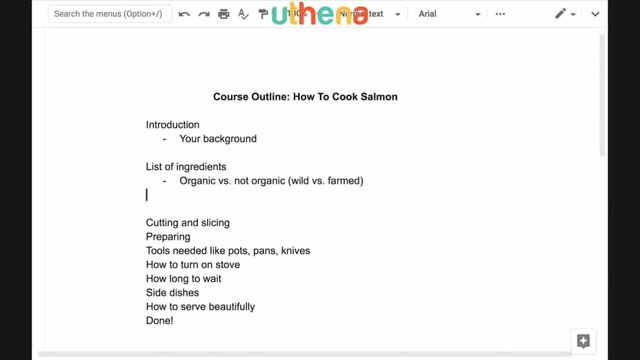
We know what is organic and not organic. Where do you buy them? Maybe budgeting and I think that will complete the ingredients section. That’s just what I don't think might be the actual definitive answer, so maybe there’s more to say on this topic, and that’s the art of comprehensive coverage.
You don’t have to have all the answers right now, as you’re going through the course you might have some ideas. I often do like, oh, something else might be really great to mention, and so you put that new idea right here. Then you teach people how to cut and slice different vegetables, different knives, thin cutting, thick cutting, how to cut fish, how to cut vegetables how to do thin versus thick cut slices, and maybe some fish is better thin, some veggies are better thick.
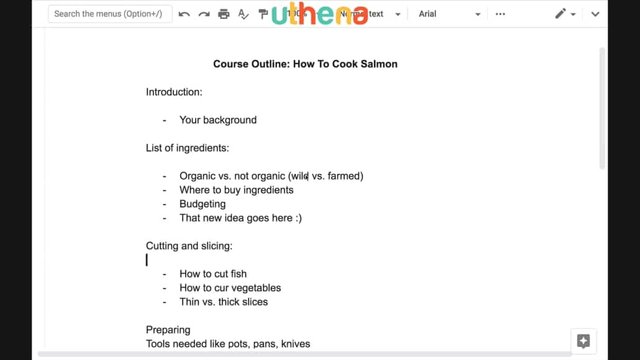
What are you’re going for and how does it all fit into the overall picture? Maybe there’s how to cook salmon maybe how to cook salmon in some specific way, and for that specific way what’s the best way to cut things so that it all makes sense, and the student ends up with the best possible dish.
For example, preparing, tools needed like pots, pans, how much space. We haven’t even started cooking but there’s already a lot of things to make sure that the student gets through the course every possible question they might have you want to preempt those questions and answer them.
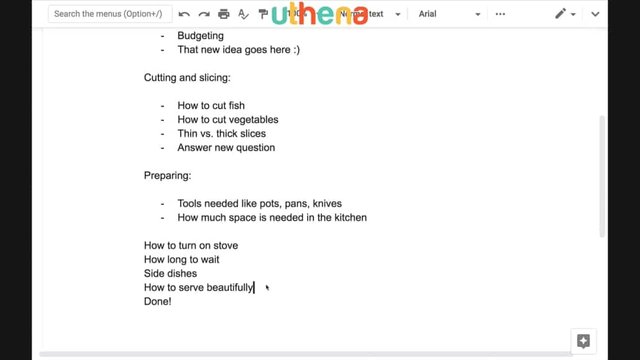
These are little points. How to cut the fish, boom done. How to cut the vegetables, boom, done. You’ll see that very quickly you’ll have this comprehensive course for them that they can just follow along very easily, no questions. If a question ever comes up, all you have to do in the future, even after your course is live, you answer this question. Because maybe you missed something and that question addresses a topic that you missed and then, boom. You just have to add another video and now it's still comprehensive. It’s even more comprehensive. You’re not missing anything so that’s essentially it.
Once you have this, this is essentially the organization of your course, then you go, boom, film this, boom, film this, boom film this. Your course filming goes way faster because everything is organized, you don’t have to second-guess yourself, you don’t have to think.
Sometimes what you’ll realize is like, well, there’s something I missed, it’s very easy to add. Let me show you how one of my courses is structured. Since I’m in the middle of filming this course, this is the pre-launch version of this course. I’m just in the middle of it.
This is inside Udemy. So Udemy gives a really cool tool for creating curriculums that you can reshuffle because if I don’t like some videos in their order I can just go flip them flip them back, and I can do the same thing with sessions and all that.
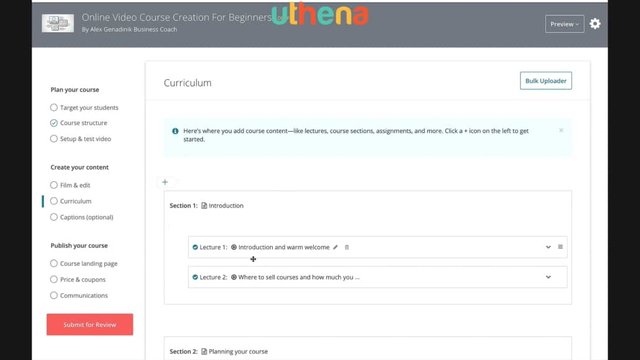
This course, this video is just being processed so I’m in the middle of creating another video now. I haven’t created a section for the course flow. It is the one that I’m creating now. How to make the course flow well, how to create an outline and when this particular video that I’m filming right now is done I’m going to go to content, video, and I’m going to be able to upload it, so it’s pretty easy and logical.
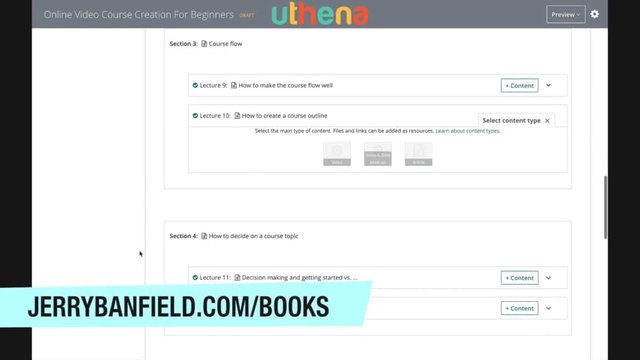
What you want to do is a logical progression so that at the end of the course, at the very end, the person who’s watching them go like, oh I’m able to do what is promised in the course. There’s a lot of stuff I haven’t filmed yet. There’s no content. There's just the kind of skeleton for it.
So what exactly is the course quality and course quality checklist that I’m planning to create and recording software that I’m planning to show you how to create.
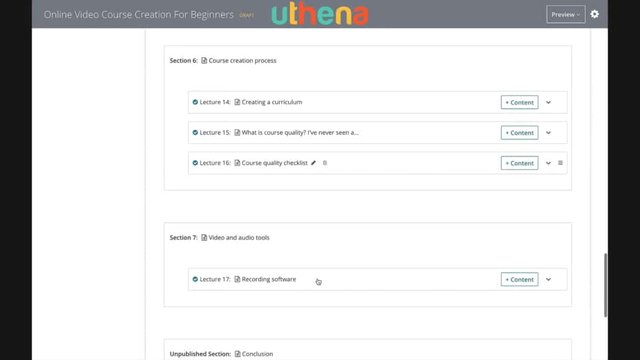
All of these things, this is my course outline, and I can shuffle and reshuffle it, so let me show you how I’ve done it for a course that’s live.
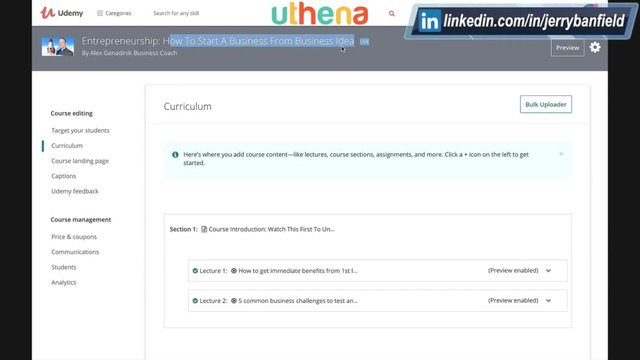
Here’s a live course it’s on how to start a business for business ideas to a successful business. There’s an introduction I started with five common business challenges, then I go how to get your ideas, how to find your niche, business ideas fundamental and evolution. Then I learned how to become more productive. That’s very important. How to protect your intellectual property - a lot of entrepreneurs worry about that - and how to write a business plan. I talk about how to raise money and start, so these are entrepreneurs that’s thinking progression.
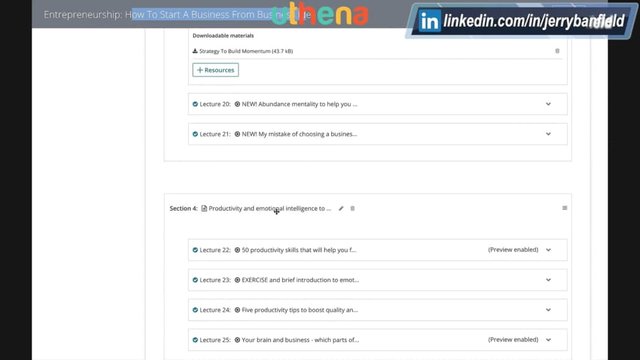
Then, of course, people ask about how to register the business, then bringing the idea into reality, the beginning to execute and getting out of theoretically dreaming about it. Case studies and examples, again, are more comprehensive. This is like lessons from Napoleon Hill - who is a very popular business writer - and we get lessons from him. I've got more entrepreneurship books, so I’ve got a lot of stuff happening here.
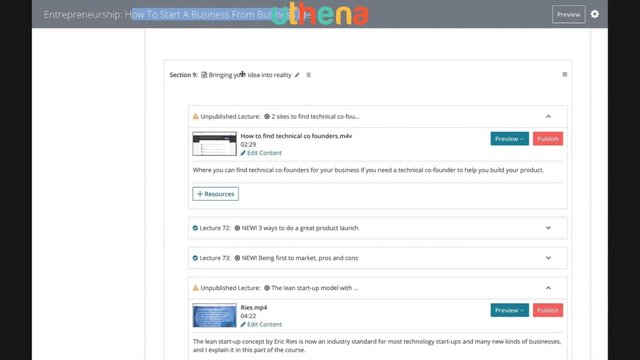
The course is done and so you see the idea of this course was to question what is going to help the first time entrepreneur not stumble into mistakes but have a perfect guide because that’s the aim of this course.
Your outline should come out of what’s the logical progression to accomplish the aim, and the promise of this course. Keep in mind you can shuffle and reshuffle throughout the creation process and even after so if you made a mistake it’s okay, it’s totally fixable.
Lesson Six: Testing Your Course.
Let’s talk about something that everybody knows they have to do but almost nobody really does and that’s testing your courses and it’s common sense, but you know no one does it almost.

Every product, every professional product needs testing so this is going to be arguably the most boring part, but if you’re looking to get better reviews, more sales, more engagement, you should really not look further than testing. You have to look within to grow without sometimes. To grow up beyond yourself and so you’re going to hate me for suggesting this but every time I’ve done this, I’ve found easily found my own fault.
It wasn’t even hard to find. When I make the courses I think wow, it’s great but it’s a faulty assumption, belief because I want to believe that it’s great so I do, but when I watch my own courses I’m like wow, I repeat myself, the audio is not as good, the video can be better, the slides can be better, so many things are bad about this course. How do people even watch it? So watch your own course in sequence - video by video - and you’ll see just how many flaws you have. That’s the easiest thing to do even though it’s boring.
Then ask others to do it. Obviously others are not going to watch your course because even if it’s boring for you, people like friends, and family, who might watch a little they’re not going to watch the whole thing. Even if they do, it will take them a long time.
Just ask them to watch one or two videos from that, they’ll give you a ton of feedback, and reread, and proofread your course title, course subtitle, and course description. Basically, little typos, little grammatical errors, just what do they do? They destroy your sales conversion rate. People who see typos or poorly phrased descriptions or grammar issues for them, that says this product is unprofessionally done, and they’re not going to buy it. They lose trust. You never know it. They never tell you but believe me it happens.
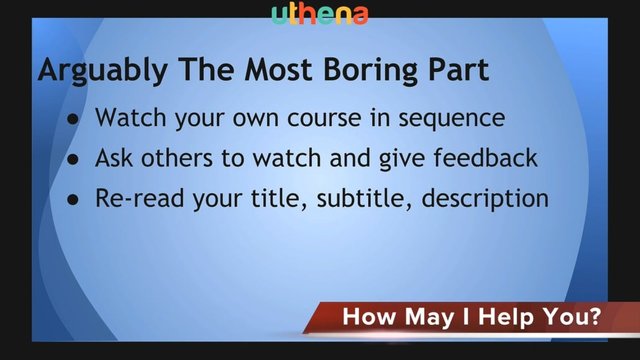
If there’s any typos, some people are absolute sticklers for grammar. If you have grammar issues, you’ve lost 5% of your buyers. As soon as you fix that you just regain them. You can still lose them with other aspects of your course, of course, but certainly there’s these grammar sticklers. I’m kind of one of them. If there’s grammar problems, I second-guess the course production quality. Make sure you at least do these three things to test and you’ll have way more engagement, way better natural reviews, and higher sales rates for your course.
Lesson Seven: Six Video Formats For Your Promotional Videos.
In this section I’ll introduce you to six different video formats that you can use for your commercial or your promotional video, and I’ll talk about the effectiveness of each. Some of them are going to be ones where you appear in the video and some of them are ones you don’t have to appear in the video. Because I know a lot of people are shy about appearing in their own promotional video and some people don’t see it any other way. We will have something for everyone.
We’ll start off with a video that you don’t have to appear in and I think it is better if you try to appear in. If it comes out terrible you can always hire someone else but I feel like it’s a fair thing to suggest to take a shot at it. Let’s say you don’t want to do that, you can easily hire a freelancer or a company to create an animation video for you.
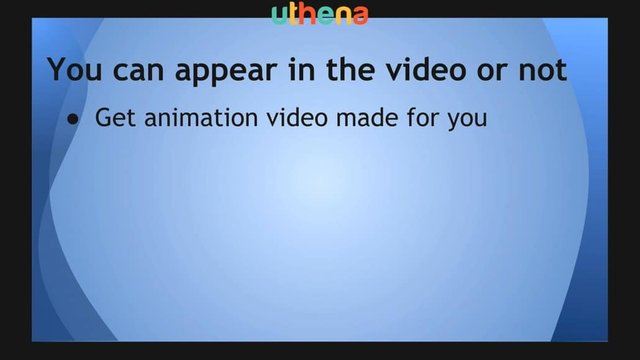
You’ll still write the script. You’ll just have them create a little animation and stuff like that, so it will look pleasant, it won't be that long, but my take on it is those videos when I watch them, they don’t particularly compel me. I guess if the script is strong and if the video flows well, and if the animation ads doesn’t subtract - if the animation isn’t clunky, if it’s not awkward and cheesy - I think it’s fine. I’d be careful because a lot of animations sometimes it’s just not great that I see and then it really takes away from the video.
The other thing you can do is you can have a professional person appear as though they are a representative of your company, but they’re a professional spokesperson. You can hire such a person relatively cheaply on Fiverr, F-I-V-E-R-R.com and they’ll create a video for you probably in a day or two or three. They’ll dress professionally, they’ll have beautiful lighting, presented well, they’ll speak well because that’s what they do. You’ll give them the script and, boom. They'll make it for you.
You don’t have to worry about the production. That’s also a reasonably good way to go. I like it because it has that human element over the cartoon - the first option is that animation cartoon - I don’t know. I kind of like having a human there. It builds trust I feel.
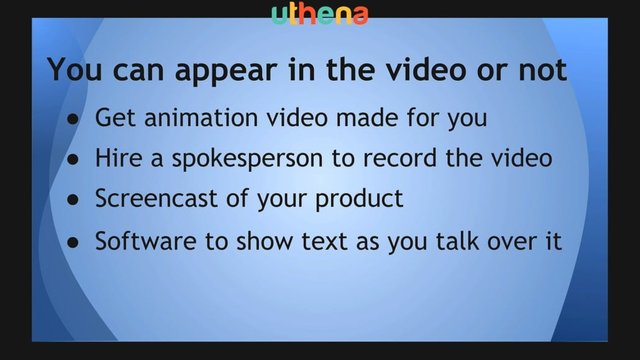
The other thing you can do if you do not want to appear in the video, you can Screencast your product. You can show people the product. If it’s an online product, especially if you can talk over it, or you can hire a freelance spokesperson to talk over it if you feel they present it better. The next thing I want to introduce you to is basically software that you can use to talk over it. It’s hard to explain it so I’ll show you what it might look like.

This is a random video that I found on YouTube it’s just basically a person talking over it and it’s just a bunch of slides you see. They just created a bunch of slides. It’s just a bunch of pictures and the slides kind of have a little bit of animation, and you just preload the slides into the software, and you can talk over the software, and have these slides going on.
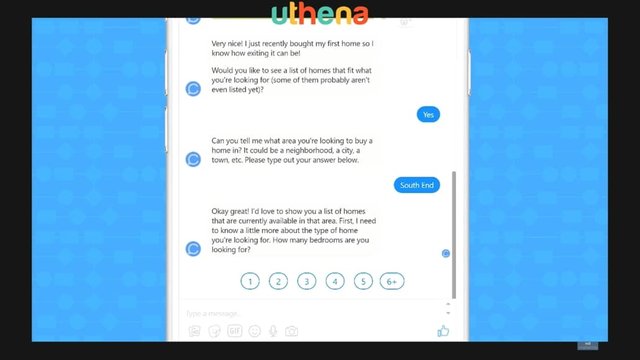
It’s a little bit like screencasting. See this video is playing and it’s kind of doing something, so it’s a little bit like screencasting but it’s not exactly casting live over you showing the product. Basically you are pre loading the different slides and you’re talking over it, so that’s that kind of a video.
Again, it’s okay; it’s very close to screencasting. You can do this with very common free tools that you get. If you have a Mac, you can make this with iMovie. There’s software packages you can also buy and if you have a PC you also have your PC preloaded with some software, and you can use that software. I’m sure I will do this job for you. This is a relatively simple video to create.
GET MORE OF THIS COURSE
Would you like to continue learning about the How To Create An Online Course To Dominate Your Niche - 2019 Course? If you are interested will you please buy the complete course, How To Create An Online Course To Dominate Your Niche - 2019 Course, on the Uthena Education Platform..
You can also get the first 1 hour and 7 minutes of the course completely for free on YouTube.
Thank you for reading the blog post or watching the course on YouTube.
I love you.
You’re awesome.
Thank you very much for checking out the How To Create An Online Course To Dominate Your Niche - 2019 Course and I hope to see you again in the next blog post or video.
You may like this post: Create YouTube Ads that Convert with Alex Genadinik!
Love,
Jerry Banfield.
Posted from my blog with SteemPress : https://jerrybanfield.com/make-money-creating-online-video-courses-alex-genadinik/
Congratulations @jerrybanfield! You have completed the following achievement on the Steem blockchain and have been rewarded with new badge(s) :
You can view your badges on your Steem Board and compare to others on the Steem Ranking
If you no longer want to receive notifications, reply to this comment with the word
STOPTo support your work, I also upvoted your post!
Do not miss the last post from @steemitboard:
Vote for @Steemitboard as a witness to get one more award and increased upvotes!
Downvoting a post can decrease pending rewards and make it less visible. Common reasons:
Submit
Great post and much to learn for readers - I particularly like the pros and cons of Udemy, probably the worlds most well-known course marketplace.
The only thing you could expand upon are the most powerful course creation platforms, like Teachable, which allow instructors full control of their 'knowledge business'.
Keep up the good work.
Downvoting a post can decrease pending rewards and make it less visible. Common reasons:
Submit